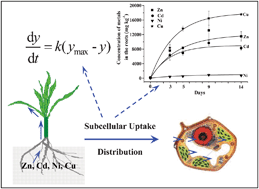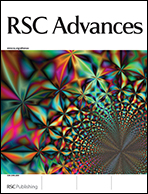The use of experimental data and the application of a kinetic model to determine the subcellular distribution of Zn/Cd/Ni/Cu over time in Indian mustard
Abstract
The precise subcellular distribution of metallic elements in plants may have a significant impact on metal detoxification and bioaccumulation processes. In this study, we report the subcellular distribution of metallic elements in Indian mustard (Brassica juncea) and the application of a kinetic model to confirm the experimental data by aqua-culture experiment. The metals in Indian mustard were determined on the 3rd, 5th, 9th, and 14th day. The results showed that concentrations of Zn, Cd, and Ni in root samples increased with exposure time, reaching maximum values of 13 161, 9602, and 864 mg kg−1 (DW), respectively, at the 9th day, while concentrations of Cu in root samples reached a maximum value of 17 566 mg kg−1 (DW) on the 14th day. A decrease in the concentration of Cu/Zn/Cd/Ni from roots to stem/leaf was observed, however, the difference in metal concentration between the roots and stem/leaf was much greater for Cu than for the other three metals. The majority of these metals were present in the cell walls, organelles, and the soluble fraction, with only minor amounts present in the cell membranes. The Zn, Cd, Ni and Cu existed mainly in the cell walls of the root on the 14th day, reaching maximum values of 424, 483, 23 and 839 mg kg−1 (fresh samples), respectively. Nearly all (90%) of the Cu existed in the cell water-soluble fraction of stems and leaves on the 3rd day, however, 44%–52% of Cu was present in the cell water-soluble fraction on the 14th day. There were also 25%–35% of Zn, 53%–60% of Cd and 70%–73% of Ni in the cell water-soluble fraction of stems and leaves. The kinetic model adequately described the experimental data for accumulation by roots, stems, and leaves. The majority of the data for the subcellular fractions of roots and stems fit the equations well. The accumulation rate constant k and the maximum accumulation capacity ymax of plant and subcellular fractions were calculated. Our results provide insight into the accumulation and subsequent subcellular distribution of metals in plants in hydroponics culture and will be valuable for further studies of phytoremediation.


 Please wait while we load your content...
Please wait while we load your content...